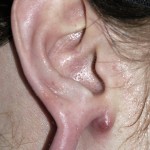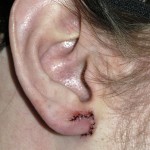Background: Earlobe stretching (often incorrectly referred to as ear gauging) is the deliberate expansion of an initially healed piercing into a much larger through and through hole. The purpose of earlobe stretching is for the ultimate purpose of wearing jewelry in the hole. Stretching is usually done in small amounts over time to avoid the potential for tearing the earlobe or causing other problems such as infection. When done too quickly or enlarged beyond the remaining blood supply of the stretched earlobe rim, the skin edges will die and separate.
The practice of earlobe stretching is based upon a well known and used plastic surgery technique…and a method seen since mankind has walked this earth. (pregnancy) Tissue expansion is the concept of using an internal device to slowly stretch out the overlying or enveloping skin. Introduced in plastic surgery for reconstruction in the early 1980s, it is now primarily used in breast reconstruction after mastectomy and in pediatric scalp reconstruction.
Ear stretching is simply applying the same concept to the earlobe. Potential complications are the same including infection, scarring, and thinning of the skin with subsequent breakdown. They are known to occur particularly when the skin stretching is done too fast and the blood supply to the skin is compromised. The earlobe is at a greater risk for this problem because the outer rim of skin is not that thick and it ends up as an expanded skin loop. Blood supply must come in only from the two sides of the loop.

Reconstruction of this earlobe defect uses a plastic surgery principle that has been created in the stretching…pedicled tube flaps. In days long gone by in plastic surgery, before the use of pedicled flaps and free tissue transfer, the tubed or walking skin flap was a primary reconstruction method. By cutting parallel incisions in skin and rolling the cut ends together, a skin tube or loop was created with the two ends remaining attached for the blood supply to get in. After allowing time for the intervening skin loop to get an enhanced blood supply, one end was released and ‘walked’ toward the defect site. Like a slinky, one end of the tubed flap was cut and reattached over time until one end of the skin loop found its way into the missing tissue area. The longer end of the separated earlobe loop is exactly a tubed flap.

While ear stretching (gauging) is a destructive fashion trend for the ear, at least it is creating more tissue by expansion. This enables secondary earlobe reconstruction, if needed, to be successfully done. In reconstructive plastic surgery, it is always better to have too much tissue. This is particularly true in the ear where extra tissue is normally hard to come by.
Case Highlights:
1) Ear stretching (gauging) is based on the plastic surgery principle of tissue expansion. When stretching too fast, necrosis of the earlobe loop can occur by compromising its blood supply.
2) Reconstruction of the split stretched earlobe can be done using a tubed flap technique. There is almost always enough tissue to recreate a normal size and shape of the earlobe.
3) Earlobe can be satisfactorily reconstructed in intact or split earlobe stretchings.
Dr. Barry Eppley
Indianapolis, Indiana


